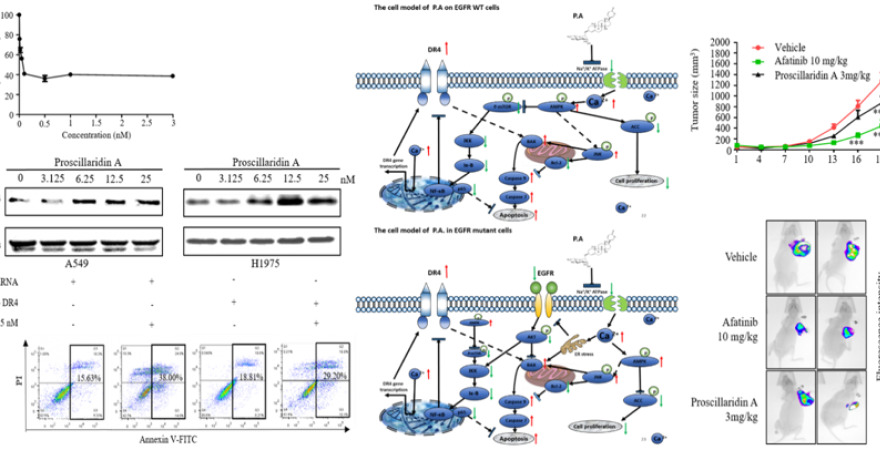Elaine’s group discovered a cardiac glycoside restrains EGFR-related and EGFR-independent NSCLC cell proliferation with distinct treatment mechanism
Non-small cell lung cancer (NSCLC) is the predominant histological type of lung cancer and is characterized by the highest mortality and incidence rates among these types of malignancies (1, 2). Traditional Chinese medicine (TCM) has been applied for centuries in China (3, 4). Cardiac glycosides, a class of natural products, have been identified as a potential type of chemotherapeutic agent (5, 6).

Recently, Elaine’s group has found out a novel anti-cancer effects and the mechanisms of action of Proscillaridin A (P.A) in NSCLC cells. In vitro sodium-potassium pump (Na+/K+ ATPase) enzyme assays indicated that P.A is a direct Na+/K+ ATPase inhibitor. P.A showed potent cytotoxic effects in NSCLC cells at nanomolar levels. Treatment mechanism studies indicated that P.A elevated Ca2+ levels, activated the AMPK pathway and down–regulated phosphorylation of ACC and mTOR. Subsequently, P.A increased death receptor 4 (DR4) expression and down-regulated NF–κB. Interestingly, P.A selectively suppressed EGFR activation in EGFR mutant cells but not in EGFR wild-type cells. In vivo, P.A significantly suppressed tumor growth in nude mice compared to vehicle-treated mice. Compared with the Afatinib treatment group, P.A displayed less pharmaceutical toxicity, as the body weight of mice treated with P.A did not decrease as much as those treated with Afatinib. Consistent changes in protein levels were obtained from Western blotting analysis of tumors and cell lines. Immunohistochemistry analysis of the tumors from P.A-treated mice showed a significant suppression of EGFR phosphorylation (Tyr 1173) and reduction of the cell proliferation marker Ki67. Taken together, our results suggest that P.A is a promising anti-cancer therapeutic candidate for NSCLC.
News mentioned Elaine group’s article:
Proscillaridin A induces apoptosis and suppresses non-small-cell lung cancer tumor growth via calcium-induced DR4 upregulation[J]. Cell Death & Disease, 2018, 9(6):696-.
References:
(1). Chen W, et al. Cancer statistics in China, 2015. CA Cancer J Clin. 2016 Mar-Apr;66(2):115-32.
(2). Siegel RL, Miller KD, Jemal A. Cancer statistics, 2015. CA Cancer J Clin. 2015 Jan-Feb;65(1):5-29.
(3). Nawaz K, Webster RM. The non-small-cell lung cancer drug market. Nat Rev Drug Discov. 2016 Apr;15(4):229-30.
(4). Leung EL, et al. Targeting Tyrosine Kinase Inhibitor-Resistant Non-Small Cell Lung Cancer by Inducing Epidermal Growth Factor Receptor Degradation via Methionine 790 Oxidation. Antioxid Redox Signal. 2016 Feb 10;24(5):263-79.
(5). Sachs G, Munson K. Mammalian phosphorylating ion-motive ATPases. Current Opinion in Cell Biology. 1991;3(4):685.
(6). Mijatovic T, et al. The alpha1 subunit of the sodium pump could represent a novel target to combat non-small cell lung cancers. Journal of Pathology. 2007;212(2):170-9.


